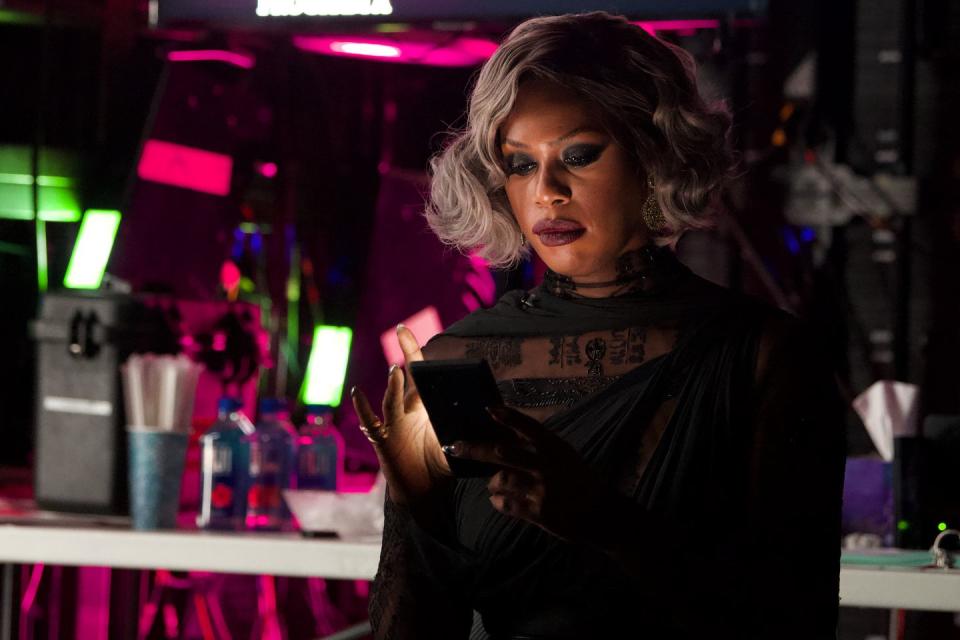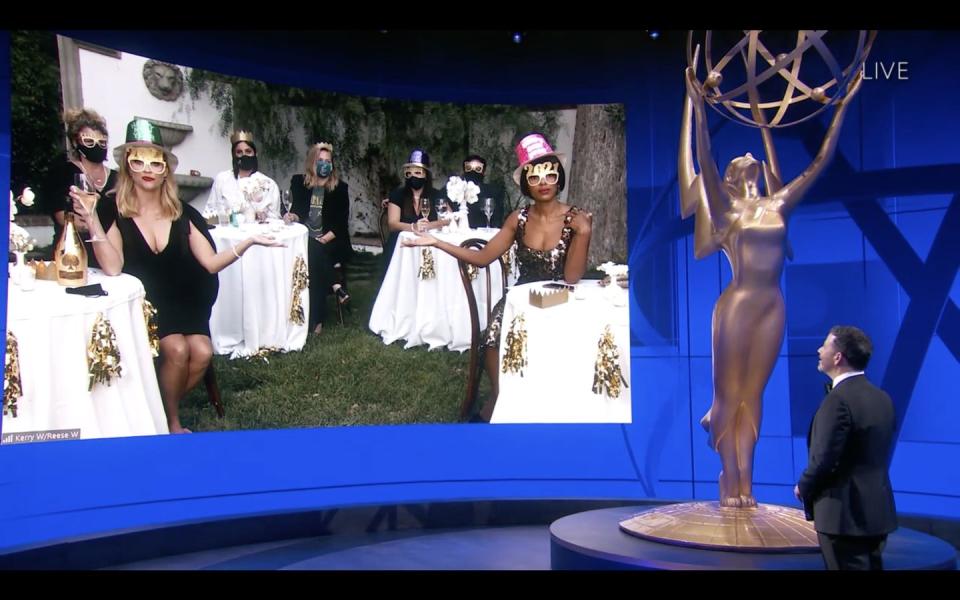Emmys 2020: In Praise of Fake Laughter


Consider, if you will, the plight of the Emmy nominee sitting in their home alone, awash in the powerful glow of a ring light, all dressed up with nowhere to go. An Emmys intern in a tuxedo hazmat suit lingers ominously outside their patio door like a deleted scene from Contagion. The red video camera light goes on, their category is announced, they don't win. They clap, the sounds of their two hands echoing off of the walls of their tastefully under-decorated room. The red light goes dark. The harbinger of doom and joy in the hazmat suit ambles away—Joe Black deciding that it's not their time yet. They change and go back to doing whatever famous people in Los Angeles do at 5 p.m. Pacific. Pilates? And that's that.
when you lose the emmy pic.twitter.com/ECkbGcoHBA
— ramy youssef (@ramy) September 21, 2020
The 72nd Emmy Awards, which aired live on ABC on Sunday night as a mix of in-studio, audience-less presentations and beamed-in spots from over 100 celebrity homes, garden parties, hotel rooms, and Canadian multi-purpose rooms, underlined the sometimes-haphazard, sometimes-ingenious ways all of us are facing the challenge of being in community while necessarily being apart. It was, at times, every Zoom birthday party you went to in the spring of this year, albeit with a higher budget. It was largely successful, if a strange substitute for the real thing. While it can't be overstated how much energy a performer has to harness to make broadcasting from an empty stage or a soundproofed room in their house compelling, the thing I kept coming back to was the feeling, so familiar to all of us, of fun happening at a distance, mediated by a screen.

I felt it when I saw Ozark's Julia Garner in full flapper garb accepting her Emmy from, apparently, a small room at Dorothy Parker's house. I thought of it when Mrs. America's Uzo Aduba won her trophy and called into the next room, "Mom! I won!" with the same cadence I used to yell through the house in the mid '90s, screaming for someone to get off the landline because I was using AOL. It loomed large as Sterling K. Brown bounded onstage to present the final award of the night, preceded by a very committed comedy bit about thinking he'd won it. Brown performed all the phases of the bit—gratitude, haughtiness, realization, mortification—without assistance, giving it the air of an audition monologue in a dark theater in front of a dispassionate director. He booked, obviously, but at what cost?
There was no way to escape the fact that everyone was in different places, that the feeling of the evening was dramatically different depending on who was in the room with you (or in Aduba's case, who was in the next room possibly watching the broadcast, possibly reading a book). This is why the Emmys were most successful in engendering a spirit of togetherness when they completely ignored reality and fully committed to prerecorded laughter and applause. Yes, the Emmys felt most real when they were at their fakest. Is that a metaphor for America? Sure. Probably. I guess. Zoom into your professor's office hours and ask them.

At the top of the broadcast, host Jimmy Kimmel performed the traditional monologue, and the director of the Emmys intercut the sounds and sights of reactions from previous broadcasts, when nominees and stars sat side-by-side in the audience. It seemed at first weird, almost gonzo—Regina King appeared twice in shots from different years and wearing different gowns. (Now that's range.) But then it started to make sense. It felt comfortable. It leaned into the fakery that has always been part and parcel of TV, and that's a good thing. Yes, this is an argument for the laugh track. May I remind you that there are no bad ideas, just ideas without a large enough marketing budget.
Perhaps I'm showing my age (I am the world's oldest living millennial), but I think laugh tracks are very useful. The industry has largely moved away from them for artistic and aesthetic reasons. To wit, none of this year's nominated comedies use one. Using a laugh track can seem déclassé, or like producers are trying to convince an audience that something is funny that really isn't. But laugh tracks come from a pure tradition that still exists across the television landscape: the live audience. Everyone laughs more when surrounded by people who are also laughing. It's hard not to get caught up in celebration or adulation in a room full of people applauding. But when's the last time you gave a standing ovation to your laptop alone in your living room? Without the social cue of canned audience response, the communal experience of television can feel emptier.
Of course, audience response isn't always 100 percent genuine, whether pre-recorded or live. When I visited the set of The Wendy Williams Show last year, I was shocked to find out that producers run the audience through a rigorous pre-show coaching session to prime the pump, teaching cues and running enthusiasm drills. It had the intensity of a Billy Blank infomercial and I was exhausted before Williams even set foot onstage. But it was a necessity. I'm not likely to applaud a macaroni and cheese cooking segment until my hands are sore at 9:30 in the morning without a little prodding. But for the viewer at home, the sound of an aggressively enthusiastic audience has the power to race through the wires (or however TV gets to your house. Carrier pigeon?) and push through the thick glass of a screen to create something that feels alive and interesting. The feeling of experiencing something at the same time other people are experiencing it is always going to be deeply compelling.

Television was always meant to be communal, but not every show needs a laugh track. The form has moved on and most of the comedies made today don't have space on the page or in the narrative for response. Dead to Me does not need my reactive commentary. Don't get me wrong, I'm going to still yell at the screen, but Christina Applegate and Linda Cardellini are doing fine without me. Even multiple winner Schitt's Creek doesn't seem to have need for laughter or applause, but I'd argue the sketch-rooted comedy Catherine O'Hara and Eugene Levy perfected absolutely has room for it. It's not necessary, but in its absence, audiences turn to platforms like Twitter to create community around the show and re-watch in unison. In the before times, Schitt's Creek would regularly show up on the TV at vacation houses I rented with friends, right after the Maya Rudolph National Anthem SNL sketch and before a compilation of "She Used to Be Mine" performances. (I'm aware this is very specific.) Sitting in a room with people teases laughter out of places it usually doesn't show up when you're by yourself or with one other person.

This resolutely disingenuous time in history is the perfect opportunity to return to our fake-ass roots and resurrect the laugh track, the clap track, and that most dramatic of responses: the collective gasp. At its best, it's a reminder that we are not alone in our feelings, which would not be terrible at the moment. I think often of a clip from The Fresh Prince of Bel-Air, a traditional multi-camera comedy which was filmed in front of a live audience. In the episode, Will's (Will Smith) father, played by Ben Vereen, has rejected him and Will turns to Uncle Phil (James Avery) for comfort. "How come he don't want me, man?" Will cries. The scene is played in silence, a rarity for network television, but at the climax, underneath Will's sobs, you can hear the sniffling of an audience member experiencing the moment in real time, 26 years in the past. To me it's an acknowledgement that, in its best iteration, the construction of an audience response track can be a vehicle for getting to the real. Television shows, particularly award shows, aren't always engaged in the project of bringing to light our shared humanity, but it often comes through anyway. We got it last night in the recorded laughter from the past, in the awkward, energy-filled silence in the present, and in our own homes, awash in the glow of a light from a square—laughing, or clapping, or sitting silently at the edge of engagement before going back to our lives. Cue the applause.
You Might Also Like


